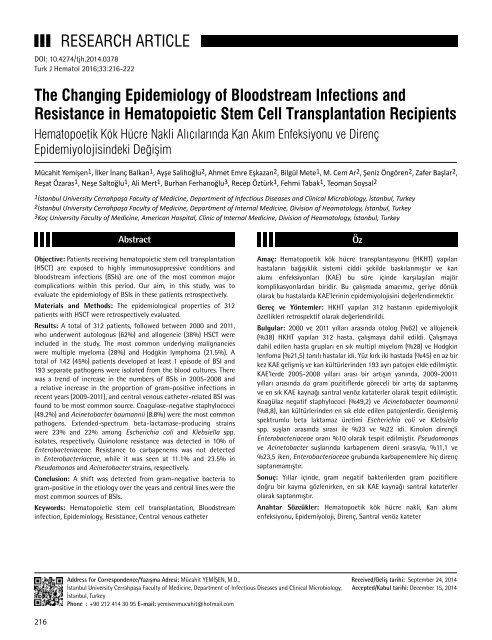Turkish Journal of Hematology Volume: 33 - Issue: 3
You also want an ePaper? Increase the reach of your titles
YUMPU automatically turns print PDFs into web optimized ePapers that Google loves.
RESEARCH ARTICLE<br />
DOI: 10.4274/tjh.2014.0378<br />
Turk J Hematol 2016;<strong>33</strong>:216-222<br />
The Changing Epidemiology <strong>of</strong> Bloodstream Infections and<br />
Resistance in Hematopoietic Stem Cell Transplantation Recipients<br />
Hematopoetik Kök Hücre Nakli Alıcılarında Kan Akım Enfeksiyonu ve Direnç<br />
Epidemiyolojisindeki Değişim<br />
Mücahit Yemişen1, İlker İnanç Balkan1, Ayşe Salihoğlu2, Ahmet Emre Eşkazan2, Bilgül Mete1, M. Cem Ar2, Şeniz Öngören2, Zafer Başlar2,<br />
Reşat Özaras1, Neşe Saltoğlu1, Ali Mert1, Burhan Ferhanoğlu3, Recep Öztürk1, Fehmi Tabak1, Teoman Soysal2<br />
1İstanbul University Cerrahpaşa Faculty <strong>of</strong> Medicine, Department <strong>of</strong> Infectious Diseases and Clinical Microbiology, İstanbul, Turkey<br />
2İstanbul University Cerrahpaşa Faculty <strong>of</strong> Medicine, Department <strong>of</strong> Internal Medicine, Division <strong>of</strong> Heamatology, İstanbul, Turkey<br />
3Koç University Faculty <strong>of</strong> Medicine, American Hospital, Clinic <strong>of</strong> Internal Medicine, Division <strong>of</strong> Heamatology, İstanbul, Turkey<br />
Abstract<br />
Objective: Patients receiving hematopoietic stem cell transplantation<br />
(HSCT) are exposed to highly immunosuppressive conditions and<br />
bloodstream infections (BSIs) are one <strong>of</strong> the most common major<br />
complications within this period. Our aim, in this study, was to<br />
evaluate the epidemiology <strong>of</strong> BSIs in these patients retrospectively.<br />
Materials and Methods: The epidemiological properties <strong>of</strong> 312<br />
patients with HSCT were retrospectively evaluated.<br />
Results: A total <strong>of</strong> 312 patients, followed between 2000 and 2011,<br />
who underwent autologous (62%) and allogeneic (38%) HSCT were<br />
included in the study. The most common underlying malignancies<br />
were multiple myeloma (28%) and Hodgkin lymphoma (21.5%). A<br />
total <strong>of</strong> 142 (45%) patients developed at least 1 episode <strong>of</strong> BSI and<br />
193 separate pathogens were isolated from the blood cultures. There<br />
was a trend <strong>of</strong> increase in the numbers <strong>of</strong> BSIs in 2005-2008 and<br />
a relative increase in the proportion <strong>of</strong> gram-positive infections in<br />
recent years (2009-2011), and central venous catheter-related BSI was<br />
found to be most common source. Coagulase-negative staphylococci<br />
(49.2%) and Acinetobacter baumannii (8.8%) were the most common<br />
pathogens. Extended-spectrum beta-lactamase-producing strains<br />
were 23% and 22% among Escherichia coli and Klebsiella spp.<br />
isolates, respectively. Quinolone resistance was detected in 10% <strong>of</strong><br />
Enterobacteriaceae. Resistance to carbapenems was not detected<br />
in Enterobacteriaceae, while it was seen at 11.1% and 23.5% in<br />
Pseudomonas and Acinetobacter strains, respectively.<br />
Conclusion: A shift was detected from gram-negative bacteria to<br />
gram-positive in the etiology over the years and central lines were the<br />
most common sources <strong>of</strong> BSIs.<br />
Keywords: Hematopoietic stem cell transplantation, Bloodstream<br />
infection, Epidemiology, Resistance, Central venous catheter<br />
Öz<br />
Amaç: Hematopoetik kök hücre transplantasyonu (HKHT) yapılan<br />
hastaların bağışıklık sistemi ciddi şekilde baskılanmıştır ve kan<br />
akımı enfeksiyonları (KAE) bu süre içinde karşılaşılan majör<br />
komplikasyonlardan biridir. Bu çalışmada amacımız, geriye dönük<br />
olarak bu hastalarda KAE’lerinin epidemiyolojisini değerlendirmektir.<br />
Gereç ve Yöntemler: HKHT yapılan 312 hastanın epidemiyolojik<br />
özellikleri retrospektif olarak değerlendirildi.<br />
Bulgular: 2000 ve 2011 yılları arasında otolog (%62) ve allojeneik<br />
(%38) HKHT yapılan 312 hasta, çalışmaya dahil edildi. Çalışmaya<br />
dahil edilen hasta grupları en sık multipl miyelom (%28) ve Hodgkin<br />
lenfoma (%21,5) tanılı hastalar idi. Yüz kırk iki hastada (%45) en az bir<br />
kez KAE gelişmiş ve kan kültürlerinden 193 ayrı patojen elde edilmiştir.<br />
KAE’lerde 2005-2008 yılları arası bir artışın yanında, 2009-20011<br />
yılları arasında da gram pozitiflerde göreceli bir artış da saptanmış<br />
ve en sık KAE kaynağı santral venöz kataterler olarak tespit edilmiştir.<br />
Koagülaz negatif staphylococi (%49,2) ve Acinetobacter baumannii<br />
(%8,8), kan kültürlerinden en sık elde edilen patojenlerdir. Genişlemiş<br />
spektrumlu beta laktamaz üretimi Escherichia coli ve Klebsiella<br />
spp. suşları arasında sırası ile %23 ve %22 idi. Kinolon dirençli<br />
Enterobacteriaceae oranı %10 olarak tespit edilmiştir. Pseudomonas<br />
ve Acinetobacter suşlarında karbapenem direni sırasıyla, %11,1 ve<br />
%23,5 iken, Enterobacteriaceae grubunda karbapenemlere hiç direnç<br />
saptanmamıştır.<br />
Sonuç: Yıllar içinde, gram negatif bakterilerden gram pozitiflere<br />
doğru bir kayma gözlenirken, en sık KAE kaynağı santral kataterler<br />
olarak saptanmıştır.<br />
Anahtar Sözcükler: Hematopoetik kök hücre nakli, Kan akımı<br />
enfeksiyonu, Epidemiyoloji, Direnç, Santral venöz kateter<br />
Address for Correspondence/Yazışma Adresi: Mücahit YEMİŞEN, M.D.,<br />
İstanbul University Cerrahpaşa Faculty <strong>of</strong> Medicine, Department <strong>of</strong> Infectious Diseases and Clinical Microbiology,<br />
İstanbul, Turkey<br />
Phone : +90 212 414 30 95 E-mail: yemisenmucahit@hotmail.com<br />
Received/Geliş tarihi: September 24, 2014<br />
Accepted/Kabul tarihi: December 15, 2014<br />
216

















